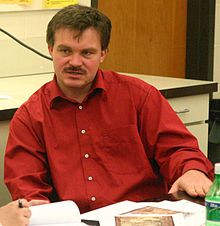- Nikolai Grube
-
Nikolai Grube is a German epigrapher.[1] He was born in Bonn in 1962.[2] Grube entered the University of Hamburg in 1982 and graduated in 1985.[2] His doctoral thesis was published at the same university in 1990.[2] After he received his doctorate, Grube moved to the University of Bonn.[3] Nikolai Grube has been heavily involved in the decipherment of the Maya hieroglyphic script.[4]
He has served as professor of anthropology and art history at both the University of Texas at Austin and the University of Bonn.[5] At the University of Bonn he has worked in the Seminar for Ethnology.[2] He has worked with several archaeological projects in the Maya region, including those at Caracol in Belize and Yaxha in the Petén Department of Guatemala.[5] He has also occupied a position at the University of Hamburg.[6] He is fluent in the Yucatec language of the modern Maya inhabitants of the Yucatán Peninsula of Mexico.[6] Nikolai Grube worked with Linda Schele in presenting hieroglyphic workshops for native Mayan speakers in Mexico and Guatemala.[7]
In the 1990s he visited Naachtun in Petén and recorded the inscriptions on the Maya stelae.[8] He is credited with deciphering the ancient name of the kingdom from the hieroglyphic inscription on Stela 1 at the city.[8] Grube, together with fellow epigrapher Simon Martin, proposed that Maya politics of the Classic Period were dominated by two so-called "superstates" ruled by the rival cities of Tikal and Calakmul.[9]
From 1992 to 1995 Grube received funding from Deutsche Forschungsgemeinschaft ("German Research Foundation") for a project investigating the oral traditions of the Cruzoob Maya of Mexico.[3] In 2010 Nikolai Grube served as one of the directors of the Interdisciplinary Latin America Center at the University of Bonn.[10] Nikolai Grube is co-editor of the Mexicon journal and is a consultant for the Mexican magazine Arqueología Mexicana ("Mexican Archaeology").[3]
Notes
- ^ Coe 1992, 1994, p.236.
- ^ a b c d Houston et al 2001, p.486.
- ^ a b c Interdisciplinary Latin America Center at the University of Bonn (1) n.d.
- ^ Coe 1992, 1994, p.236. Houston et al 2001, p.486.
- ^ a b Martin & Grube 2000, inside back cover.
- ^ a b Coe 1992, 1994, p.228.
- ^ Martin 1998.
- ^ a b Reese-Taylor, 15 October 2010.
- ^ Webster 2002, p.168.
- ^ Interdisciplinary Latin America Center at the University of Bonn (2) n.d.
References
-
- Coe, Michael D. (1992, 1994). Breaking the Maya Code. London: Thames & Hudson. ISBN 0-14-023481-0. OCLC 31288285.
- Houston, Stephen; Oswaldo Fernando Chinchilla Mazariegos and David Stuart (eds.) (2001). The Decipherment of Ancient Maya Writing. University of Oklahoma Press. ISBN 9780806132044. OCLC 44133070.
- Interdisciplinary Latin America Center (1). "Nikolai Grube" (PDF). Bonn, Germany: Interdisciplinary Latin America Center at the University of Bonn. http://www.ilz.uni-bonn.de/cv/cv_grube_esp.pdf. Retrieved 2010-12-14. (Spanish)
- Interdisciplinary Latin America Center (2). "Board of Directors". Bonn, Germany: Interdisciplinary Latin America Center at the University of Bonn. http://www.ilz.uni-bonn.de/Direktorium_en.html. Retrieved 2010-12-14.
- Martin, Simon (22 May 1998). "Obituary: Linda Schele". The Independent. London: independent.co.uk. http://www.independent.co.uk/news/obituaries/obituary-linda-schele-1158003.html. Retrieved 2010-12-14.
- Martin, Simon; and Nikolai Grube (2000). Chronicle of the Maya Kings and Queens: Deciphering the Dynasties of the Ancient Maya. London and New York: Thames & Hudson. ISBN 0-500-05103-8. OCLC 47358325.
- Reese-Taylor, Kathryn (15 October 2010). "Naachtun: A Lost City of the Maya". BBC. http://www.bbc.co.uk/history/archaeology/excavations_techniques/maya_naachtun_01.shtml. Retrieved 2010-12-12.
- Webster, David L. (2002). The Fall of the Ancient Maya: Solving the Mystery of the Maya Collapse. London: Thames & Hudson. ISBN 0-500-05113-5. OCLC 48753878.
Categories:- Epigraphers
- German anthropologists
- University of Texas at Austin faculty
- University of Bonn faculty
- Living people
- University of Hamburg faculty
Wikimedia Foundation. 2010.

